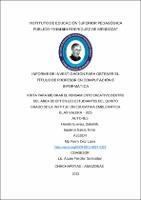| dc.contributor.advisor | Mg. Fanny Cruz Lopez | es_PE |
| dc.contributor.author | Heredia Guevara, Duberlith | es_PE |
| dc.contributor.author | Izquierdo Garcia, Nilser | es_PE |
| dc.date.accessioned | 2025-07-01T17:25:41Z | |
| dc.date.available | 2025-07-01T17:25:41Z | |
| dc.date.issued | 2023-12-28 | |
| dc.identifier.uri | http://hdl.handle.net/123456789/43 | |
| dc.description.abstract | The present research entitled Krita to improve the creative thinking in the
Education fot Work subject in fith - grade “A” students at Blas Valera School2023;has been developed based on a problem observed in the students; where the lack
of creativity for the preparation of works in the different areas could be noticed, in
which they do not generate their own ideas or think how they can do it, but wait for
teachers to tell them what things to do or simply imitate other works and designs of
the internet that other people have done, which together with other factors prevent the
student from developing their imagination and thinking, that is why in the XXI
century it was decided to use a technological resource to improve creativity in natives
Digital. The research was carried out with the aim of demonstrating the extent to
which Krita influences the improvement of creative thinking in the Education for
Work subject in students in the fifth grade A of the secondary level; using a
quantitative research approach, with a pre-experimental design; having a sample of
18 students of fifth grade A at the secondary level, obtaining favorable improvements,
which is demonstrated through the measures of central tendency and in the assessment
scales; concluding that students' use of the Krita program had a positive and
significant impact on increasing the level of creativity; since in the post-test an
average of 14 was obtained with 5 points difference to what was obtained in the pretest which was 09, which confirms the improvement of creativity in the students,
showing a great difference from how they were at the beginning. | es_PE |
| dc.description.tableofcontents | RESUMEN..................................................................................................................ii
ABSTRACT...............................................................................................................iii
DEDICATORIA........................................................................................................ iv
AGRADECIMIENTO ............................................................................................... v
ÍNDICE DE CONTENIDO...................................................................................... vi
INTRODUCCIÓN ..................................................................................................... 1
CAPÌTULO I
1. PROBLEMA DE INVESTIGACIÒN............................................................... 2
1.1 Planteamiento del problema .......................................................................... 2
1.2 Formulación del problema............................................................................. 3
1.2.1 Problema principal. ................................................................................ 3
1.2.2 Problemas específicos. ........................................................................... 3
1.3 Objetivos de la investigación ........................................................................ 4
1.3.1 Objetivo general..................................................................................... 4
1.3.2 Objetivos específicos. ............................................................................ 4
1.4 Formulación de las hipótesis......................................................................... 4
1.4.1 Hipótesis general.................................................................................... 4
1.4.2 Hipótesis específicas. ............................................................................. 5
1.5 Justificación de la investigación.................................................................... 5
1.5.1 Teórica.................................................................................................... 5
1.5.2 Metodológica.......................................................................................... 5
1.5.3 Práctica................................................................................................... 6
CAPÍTULO II
2. MARCO TEÓRICO........................................................................................... 7
2.1. Antecedentes de la investigación................................................................... 7
2.2. Bases teóricas ................................................................................................ 9
2.3. Definición de términos básicos ................................................................... 16
CAPÍTULO III
3. METODOLOGÍA Y ESTRATEGIAS DE INVESTIGACIÒN ................... 18
3.1. Identificación de las variables de investigación .......................................... 18
3.1.1. Definición conceptual. ......................................................................... 18
3.1.2. Definición operacional......................................................................... 18
3.2. Tipo, nivel y diseño de la investigación ...................................................... 21
3.3. Población y muestra .................................................................................... 23
3.4. Técnicas e instrumentos de recolección de datos........................................ 24
3.5. Proceso de prueba de hipótesis y análisis de datos...................................... 26
CAPÍTULO IV
4. DESCRIPCIÓN DE LOS ANÁLISIS, RESULTADOS................................ 28
4.1. Resultados ................................................................................................... 28
CAPÍTULO V
5. DISCUSIÓN, CONCLUSIONES Y RECOMENDACIONES ..................... 40
5.1. Discusión ..................................................................................................... 40
5.2. Conclusiones ............................................................................................... 42
5.3. Recomendaciones........................................................................................ 43
REFERENCIAS BIBLIOGRÁFICAS................................................................... 44
APÉNDICES Y ANEXOS
ÍNDICE DE TABLAS
Tabla 1. Variable independiente................................................................................ 20
Tabla 2. Instrumento de evaluación de la variable independiente ............................ 20
Tabla 3. Variable dependiente................................................................................... 20
Tabla 4. Instrumento de evaluación de la variable dependiente ............................... 21
Tabla 5. Población de estudio ................................................................................... 23
Tabla 6. Muestra de estudio ...................................................................................... 24
Tabla 7. Dimensión fluidez: pre test ......................................................................... 28
Tabla 8. Dimensión flexibilidad: pre test.................................................................. 29
Tabla 9. Nivel de pensamiento creativo: pre test ...................................................... 31
Tabla 10. Cálculo de estadística descriptiva: pre test................................................ 32
Tabla 11. Dimensión fluidez: pos test....................................................................... 33
Tabla 12. Dimensión flexibilidad: pos test ............................................................... 34
Tabla 13. Nivel de pensamiento creativo: pos test.................................................... 35
Tabla 14. Cálculo de estadística descriptiva: pos test ............................................... 36
Tabla 15. Comparativo del nivel de pensamiento creativo entre pre y pos test........ 37
ÍNDICE DE GRÁFICOS
Gráfico 1. Nivel de logro en la dimensión fluidez: pre test ...................................... 29
Gráfico 2. Dimensión flexibilidad: pre test............................................................... 30
Gráfico 3. Nivel de pensamiento creativo: pre test ................................................... 31
Gráfico 4. Dimensión fluidez: pos test...................................................................... 33
Gráfico 5. Nivel de logro en la dimension flexibilidad: pos test............................... 35
Gráfico 6. Nivel de pensamiento creativo: pos test................................................... 36
Gráfico 7. Comparativo de nivel de pensamiento creativo: pre y pos test................ 38 | es_PE |
| dc.format | application/pdf | es_PE |
| dc.language.iso | spa | es_PE |
| dc.relation | KRITA PARA MEJORAR EL PENSAMIENTO CREATIVO DENTRO DEL ÁREA DE EPT EN LOS ESTUDIANTES DEL QUINTO GRADO DE LA INSTITUCIÓN EDUCATIVA EMBLEMÁTICA BLAS VALERA – 2023 | es_PE |
| dc.rights | info:eu-repo/semantics/openAccess | es_PE |
| dc.subject | Investigación | es_PE |
| dc.title | KRITA PARA MEJORAR EL PENSAMIENTO CREATIVO DENTRO DEL ÁREA DE EPT EN LOS ESTUDIANTES DEL QUINTO GRADO DE LA INSTITUCIÓN EDUCATIVA EMBLEMÁTICA BLAS VALERA – 2023 | es_PE |
| dc.type | info:eu-repo/semantics/bachelorThesis | es_PE |
| dc.type.version | info:eu-repo/semantics/publishedVersion | es_PE |
| dc.publisher.country | PE | es_PE |
| dc.subject.ocde | https://purl.org/pe-repo/ocde/ford#5.03.00 | es_PE |
| renati.author.dni | 73595396 | |
| renati.author.dni | 63300179 | |
| renati.advisor.orcid | https://orcid.org/0009-0001-8557-6329 | es_PE |
| renati.advisor.dni | 42485942 | |
| renati.type | https://purl.org/pe-repo/renati/type#trabajoDeInvestigacion | es_PE |
| renati.level | https://purl.org/pe-repo/renati/nivel#tituloProfesional | es_PE |
| renati.juror | P: Tafur Angulo, Julio | es_PE |
| renati.juror | S: Rimaicuna Chero, Luis Armando | es_PE |
| renati.juror | V: Culqui Gaslac, Merci Arcidia. | es_PE |
| thesis.degree.name | Profesor en Computación e Informática. | es_PE |
| thesis.degree.grantor | Instituto de Educación Superior Público Pedagógico "Toribio Rodríguez de Mendoza" | es_PE |
| thesis.degree.discipline | Computación e Informática. | es_PE |



